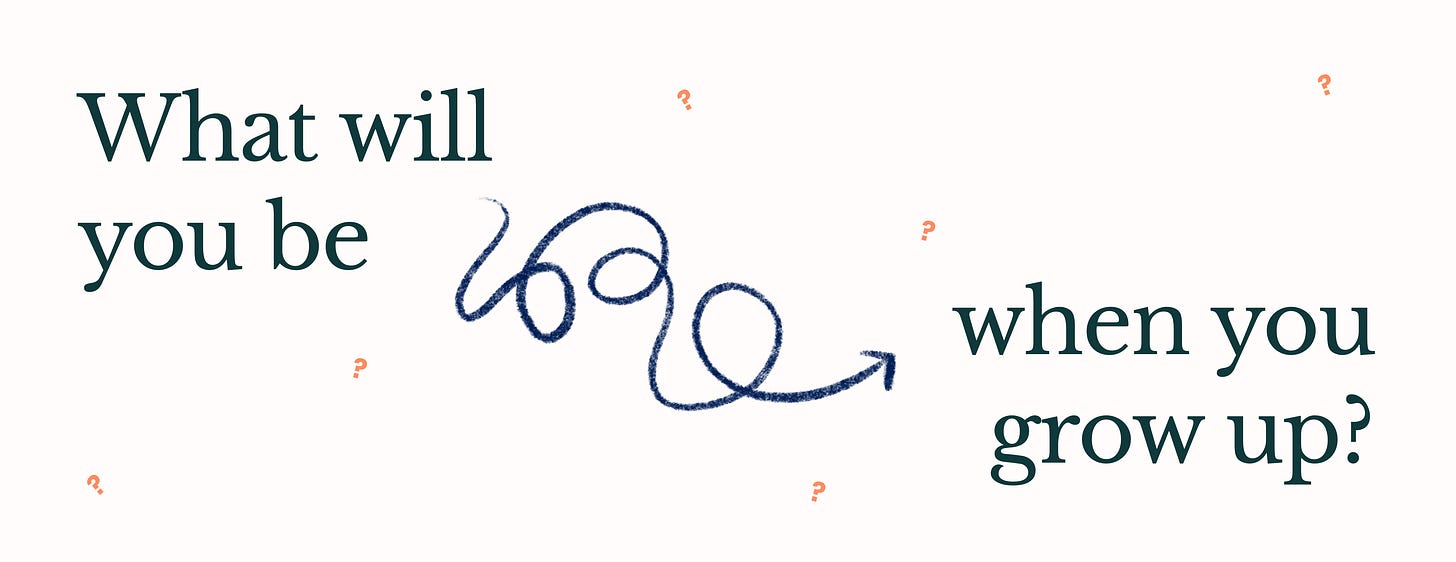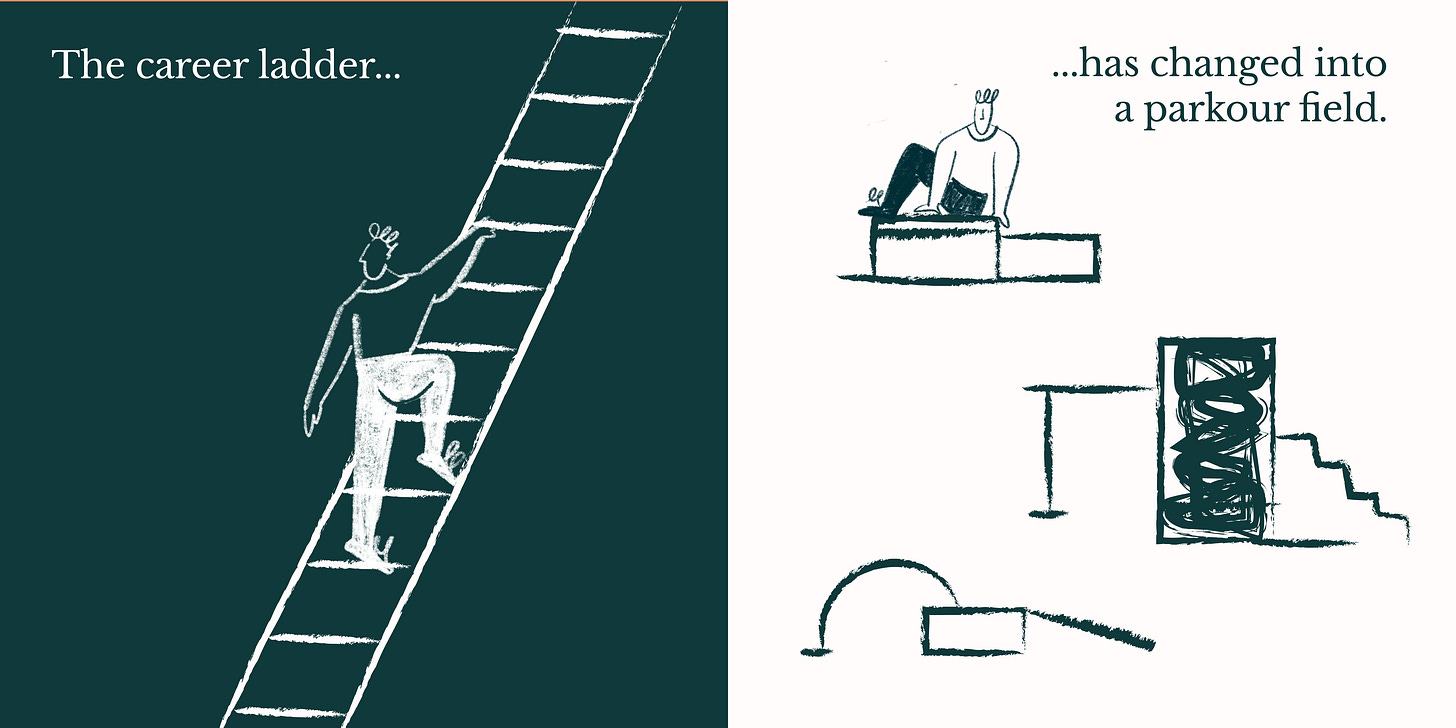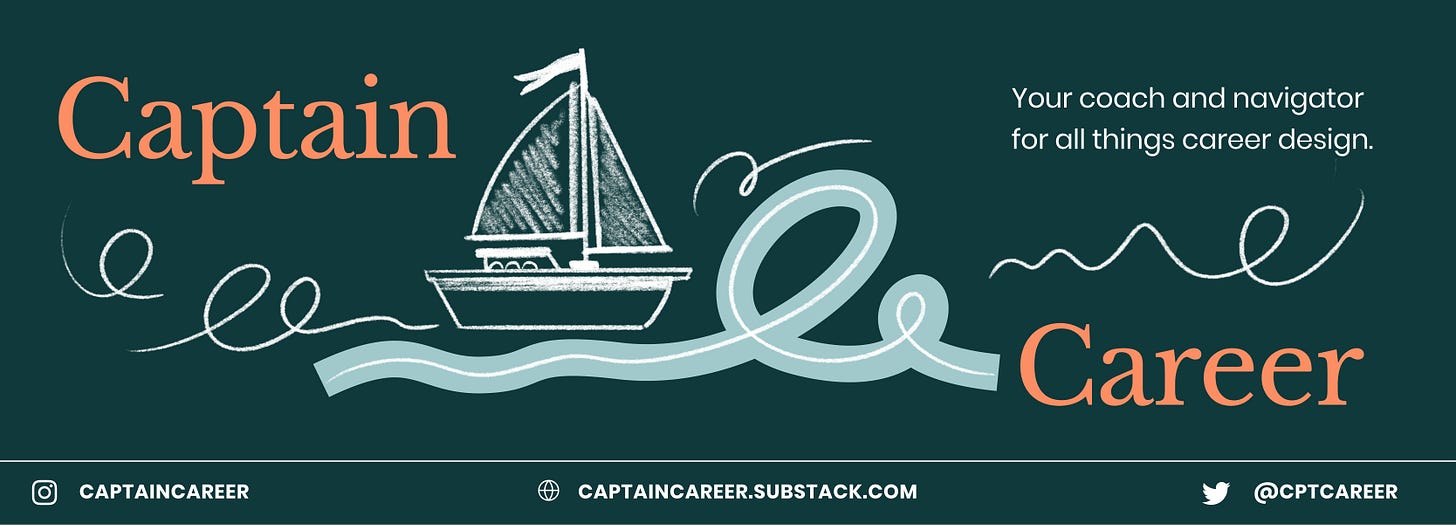Career Design: How design thinking can help you create a career you love
Post One in the Captain Career Series
Captain Career is a series of blog posts detailing how to use the design thinking process to design your career. It’s brought to you by Crew, the career platform for people who want to design fulfilling careers. Current writing and illustration are a collaboration between Crew co-founder Mollie Amkraut Mueller and creator-in-residence Charlota Blunarova.
In this introductory post, we explain why design thinking is such a great tool for careers. In future posts, we elaborate on how you can apply design thinking to your career.
This question both intrigued and puzzled us as kids. We’re sure you remember wrestling with it as well.
Early in life, Mollie was convinced she would grow up to be a professional flower girl. Charlota was destined to become an ice-skating champion.
But as we grew into adults (if we admit that’s what we are now!), it doesn’t seem that we have yet landed on one answer. Mollie’s first job after university was auditing in a big accounting firm. She’s since pivoted from accounting to innovation consulting and now to entrepreneurship (with quite a few bumps, detours, and engine stalls along the way).
Charlota's childhood dream of becoming a professional ice skater didn't work out (after the first lesson). For a brief moment, she thought about becoming a lawyer to 'wear nice suits often' - but then her love for beautiful objects led her to first study industrial design, then photograph weddings and later help companies build strong brands.
Maybe you’re also from the generation who set out to pick one career path.
And on the way have somehow found yourself with changing titles on a business card, working in a different field than what you studied, or stitching together a few different concurrent jobs and activities to achieve your financial and fulfillment goals at the same time.
From looking back on our own careers, and studying those of people around us, a few things have become remarkably clear:
There is no one direction anymore.
The career ladder has changed into a parkour field.
And, during our lifetime, we can expect to have many different jobs, often optimizing for what matters most at our life stage.
This can feel exciting and full of possibilities.
But also scary and ambiguous.
The magic of that childhood question what do you want to be when you grow up can sometimes get enveloped by the only too common adult worries of why haven’t I figured this out yet? Is it possible to have both money and meaning? Or even, is it too late to find work that I love?
But given that the shape of our careers has changed so dramatically, it’s only natural that we continue to ask ourselves what do I want to be when I grow up?
What if we could reframe this question in a way that makes us harken back to our days as kids, when we were full of confidence and imagination?
As designers and career nerds, we love this question and want to make sure it retains its childhood magic, its flavor of exploration and originality. So we got to thinking about the right way (and fun way) to answer it. The best approach for finding work that you love.
We both spent four years working at IDEO, a leading design and innovation firm. There we used a problem-solving framework called design thinking as we helped corporations solve complex, future-facing challenges.
Design thinking is a process that borrows principles from traditional design, like human-centered research, analogous inspiration, prototyping, and storytelling, to solve a wide variety of challenges.
From innovating milk products to redesigning entire food systems.
From creating a safe and comfortable car interior to envisioning the future of cities with autonomous vehicles.
As we spent our days applying design thinking to the future of corporations, it became apparent just how applicable the design thinking process is to figuring out one’s career. The more we thought about it and tested it on our own careers, the more convinced we became. Charlota started giving talks about how she uses the designer’s toolkit to experiment in her career and was seeing eyes light up as she explained the process. Mollie started a new venture to help people explore their careers using design thinking. We have each now seen enough impact from this process that we felt inspired to put it into writing and drawing. To articulate for ourselves, and to share with more people, how to use a designer’s toolkit to design a career you love.
In a series of upcoming posts, we’ll explain how to apply design thinking to careers by chunking it up into two categories:
The Activities and The Mindsets.
We’ll write a post for each of our favorite design activities and mindsets, explaining what it is and how you can apply it to your career. But first, let’s dig more into why we think design thinking is the right process for navigating one’s career.
Why use Design Thinking?
Design Thinkers love a complex problem with many possible solutions. We’re trained in embracing ambiguity, divergent thinking, and imagination, so big open-ended problems are our jam. This is different from other problem-solving techniques, like analytical, engineering, and optimization processes. Those processes arrive at the best answer, but in Design Thinking, there are multiple best answers.
Here are some examples of problems where design thinking shines:
The motorcycle market is shrinking (How might we increase motorcycle ownership amongst younger generations?)
Dieting is hard (How might we make it easier to choose healthy food?)
Vehicle downtime is frustrating (How might we improve the vehicle maintenance experience?)
Shipping clothes requires too much plastic (How might we remove waste from retail packaging?)
Each of these challenges could have multiple solutions, and we can’t simply look to past data or lab-based experiments to find an answer. Instead, we research, brainstorm, and test different ideas to see which are most likely to succeed.
Here are some examples of problems that should not be solved by design thinking:
Inventing a vaccine
Building a battery for an electric car
Assembling a stock portfolio
Reducing the number of hours needed to build an airplane
Deciding which sales leads to prioritize
When you think about each of these problems, while you don’t know the answer yet, you know what the answer is going to look like, and it’s your job to fill in the blank. You don’t need a creative process, you need an analytical process.
When using design thinking, we tend not to know the shape of the final output until we’re in the thick of it.
Careers also have multiple answers.
Does this sound surprising? We are influenced to believe that there are a limited number of desirable careers, and that we should constantly analyze our options and optimize our path (that path also often looks suspiciously similar to the paths of everyone around us). But the idea of one path or one dream career is both wrong and incredibly unhealthy.
There are multiple fulfilling, bill-paying, and joy-inducing paths for each one of us. The barrier is that many of us don’t know how to uncover them. And that’s where career design comes in--the process in which we apply principles of design to our careers, and the subject of this series of blog posts.
In subsequent posts, we’ll break down some of our favorite career design activities and show how they can be applied to careers.
And who will guide us on this creative odyssey?
Introducing Captain Career - your coach and navigator for all things career design. Ahoy!
Subscribe to be first in line to read the next post.
Follow Captain Career via Instagram and Twitter for more frequent career design inspiration. Check out Crew on the web, Instagram, and LinkedIn if you’re looking for a career design coach and team.
Thank you to Virginia, Miriam, Brad, & Robert for reading drafts of this post.
Captain Career is written by Mollie and Charlota.
Mollie Amkraut Mueller is an accountant turned business designer turned entrepreneur who is now building Crew, a cohort-based coaching program that helps professionals design careers they love. She hails from Seattle and currently lives in London with her husband and crazy goldendoodle puppy. When she’s not nerding out on careers, she can be found spending time outdoors, giving museum tours on 18th-century French art, or watching classic British reality TV.
You can follow Crew via LinkedIn, Instagram, and Twitter
Charlota Blunarova is a designer-generalist, who loves building brands and products. After living in Boston and Munich, she’s now based in the beautiful Prague, taking a creative sabbatical to actively prototype the next direction of her career. She is a plant parent to a wild home jungle, an explorer of the decentralized web, and curious about how technology transforms the relationship we have with our jobs. She used to be a wedding photographer and probably tasted more wedding cakes than anyone else (not bragging - that’s just facts!). She is also Crew’s current creator-in-residence.
Both Mollie and Charlota spent several years at the leading design firm IDEO helping clients around the world to think more creatively and build better products and services.








